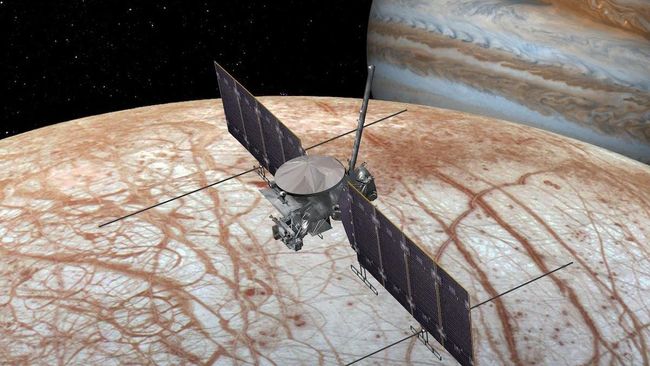Europa Clipper should reach Jupiter's icy moon Europa in 2030
In October of this year, NASA plans to send a trip to one of the 92 known satellites of Jupiter — Europe. The mission of this spacecraft, called Europa Clipper, is to help scientists determine whether Europa can support life as we know it. According to a message posted on NASA's website on January 30, Europa Clipper is now fully prepared for its journey, as all nine science instruments and the telecommunications system have been installed.
Europa Clipper is equipped with scientific equipment, including a mass spectrometer designed to measure the mass-to-charge ratio of gas molecules on Europa, a surface analyzer and an imaging spectrometer to study the interactions of light and matter to produce a detailed map of lunar ices, salts and organic molecules. Also on board the Europa Clipper are cameras that will take pictures of Europa's icy surface.
Obtaining new and detailed data on Europa's surface is an important step toward explaining a number of puzzling observations. For example, a study that was conducted using another NASA spacecraft — «Juno», suggests evidence of recent activity on Europa. At the same time, Europa Clipper should arrive in the Jupiter system no earlier than 2030. It will be in orbit for at least four years and will perform 49 close flybys of Europe.
«We will explore Europa from its core and rocky interior to the ocean and its icy shell, study its very thin atmosphere and the environment of space», — said Robert Pappalardo, mission scientist for the Europa Clipper mission.
This mission is considered extremely important, since many scientists consider Europa one of the most promising places to search for evidence of the presence of life in our solar system. Europa meets many of the requirements for life as we know it, including the presence of a salty sub-ice ocean. Scientists are so inspired by the idea of icy moons with sub-ice oceans that they have begun developing plans to create cryobots that can penetrate under the icy crust. Last year, the James Webb Space Telescope succeeded in detecting carbon in the oceans of Europe.
It is also possible that Europa's icy surface contains plumes of water vapor. Studying these plumes is important for the mission, as the vehicle will be able to collect samples from the interior of the satellite without landing on it. The spacecraft is not intended to land, but will collect data, setting the stage for future missions that include a lander to explore Europa.
Europa Clipper will be equipped with an ultraviolet spectrograph to detect plumes of water vapor and determine how the properties of the dynamic atmosphere change over time. This data will be invaluable for understanding the ocean, since the electrical conductivity of salty ocean water creates or implies the existence of a magnetic field as Europa moves through Jupiter's strong magnetic field. In addition, the instrument, paired with a magnetometer, will probe the plasma around Europa, which can distort magnetic fields, providing new data on the satellite's state.
Also as part of the Europa Clipper mission, the radar will send radio waves to the surface of Europa, and then analyze their reflection from various objects on the icy surface and in the ocean. This will allow you to determine the approximate distance to these objects. This research will provide a detailed picture of what Europe looks like under the ice. Antennas for this instrument are scheduled to be delivered in the second half of this year.
The Europa Clipper mission represents a major milestone in the exploration of Europa and the search for extraterrestrial life in our solar system. The scientific data collected by this mission will help improve our understanding of the range of conditions that support life on other planets.

